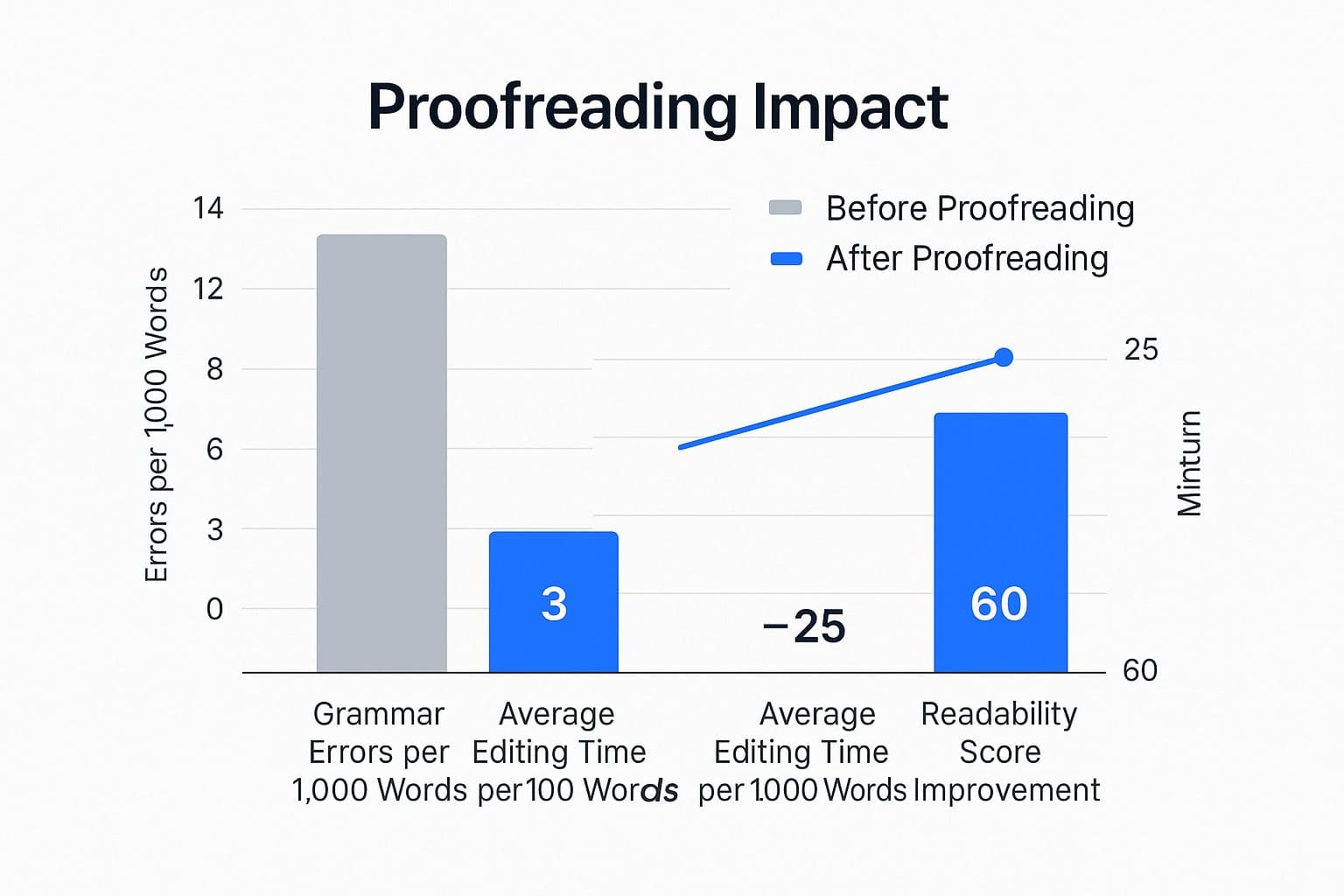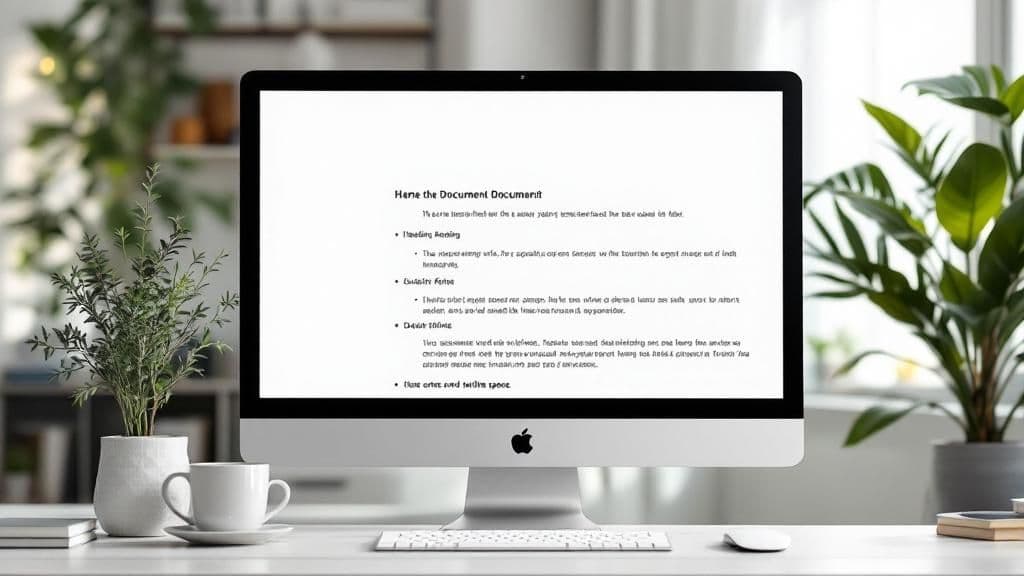How to Write Professionally and Impress Anyone
Learn how to write professionally with our guide. Discover actionable tips on clarity, tone, and structure to make your business writing clear and effective.

When someone talks about learning to write "professionally," they're really talking about prioritizing the reader's time. It's not about sounding formal or using big, stuffy words. It's about being clear, direct, and efficient so your message lands perfectly on the first read. This is how you build trust and authority with every single word you write.
What Professional Writing Really Means Today

Let's get one thing straight: professional writing today has nothing to do with poring over a dusty thesaurus to find the most complicated word. In our fast-paced world, it’s all about communicating with respect for your audience's attention span.
At its core, modern professional writing boils down to a few powerful principles. You want to deliver your point without the fluff, structure your thoughts in a way that makes sense, and adapt your tone to the situation—whether you're firing off a quick project update, a crucial client email, or a detailed report.
Set Your Goal Before You Type a Single Word
Every single piece of professional writing needs a clear objective. Before you even think about your opening line, stop and ask yourself: What do I need my reader to know, feel, or do after they've read this?
This one question is your North Star. It guides every choice you make, from the words you pick to the way you structure your sentences.
Think about it. An email to your team might be purely informational—letting them know a deadline has shifted. But a report for a stakeholder is persuasive—you're trying to get them to approve a budget. Defining your purpose from the get-go stops you from rambling and ensures your message actually has a point. Without a clear goal, your writing will fall flat, no matter how grammatically perfect it is.
Key Takeaway: The ultimate goal of professional communication isn't just to be understood, but to ensure there's no possibility of being misunderstood. Clarity removes friction and builds momentum.
Know Your Audience Inside and Out
Just as crucial as your goal is understanding who you're writing for. Is it a C-suite executive who has maybe 60 seconds to scan your message, or a technical colleague who needs every single detail laid out? Adjusting your language, tone, and the depth of information for your reader is the true mark of a professional writer.
To help you get a quick sense of the difference, this table breaks down the key characteristics of professional versus casual writing.
Professional vs Casual Writing at a Glance
This table contrasts the key characteristics of professional and casual writing to help you quickly identify what to aim for and what to avoid in a business context.
| Characteristic | Professional Writing | Casual Writing |
|---|---|---|
| Purpose | To inform, persuade, or document with a clear objective. | To entertain, connect socially, or express oneself. |
| Audience | Clearly defined (colleagues, clients, management). | General or informal (friends, family, followers). |
| Tone | Objective, respectful, and context-appropriate. | Subjective, personal, and often emotional. |
| Language | Precise, clear, and free of jargon and slang. | May include slang, emojis, and colloquialisms. |
| Structure | Logical, well-organized with clear headings. | Often unstructured, following a stream of thought. |
| Grammar/Spelling | Impeccable, follows standard conventions. | May be relaxed or contain errors. |
Using this as a mental checklist can instantly sharpen your focus before you start writing.
This approach isn't just about sounding good—it has a direct impact on business success. High-quality writing is the engine behind everything from marketing to internal comms. The content marketing industry, for example, is projected to hit over $107 billion in revenue by 2026, a growth fueled by effective writing that gets results. This skill isn’t a "nice-to-have"; it's a critical business asset.
For anyone looking to turn these skills into a career, understanding how to become a content creator is a fantastic real-world example. It shows how polished, professional writing is the foundation for building an authoritative and trusted online presence. Ultimately, knowing your audience is how you build that trust, proving you value both their time and their perspective.
Write With Unmistakable Clarity and Precision

If a reader has to stop and reread a sentence to figure out what you mean, you've already lost them. The point of professional writing isn't to show off your vocabulary; it's to get your ideas across so clearly that they're impossible to misunderstand. You have to cut through the fluff and be direct.
I always think of it this way: your reader has a limited amount of mental energy. Don't make them burn it trying to untangle a messy sentence or guess your meaning. Make every single word count.
Choose Active Voice
One of the fastest ways to inject some life into your writing is by using the active voice. It's direct, it's punchy, and it shows you're taking ownership of your statements.
Take a classic passive sentence you've probably seen a million times: "The report was completed by the marketing team." Sure, it's grammatically correct, but it feels a bit weak and indirect.
Now, let's flip it to active: "The marketing team completed the report." Feel the difference? It's shorter, has more energy, and immediately tells us who did what. It’s a small tweak that makes your writing sound way more confident.
Ditch the Fluff and Jargon
Truly professional writing doesn't hide behind buzzwords and corporate jargon. In my experience, that kind of language just builds a wall between you and your reader, making your message sound generic and soulless.
A clear message is a sign of respect for your reader's time and intellect. It shows you've done the hard work of simplifying your thoughts so they don't have to.
So instead of saying you'll "leverage core competencies to circle back," just say you'll "use your skills to follow up." Being direct builds trust and makes sure everyone's on the same page. Nailing this kind of conciseness, like when you how to write meta descriptions, is a game-changer for making a professional impact.
Keep Sentences and Paragraphs Short
We all have screen fatigue. Huge walls of text are intimidating, so do your readers a favor and break things up. Short paragraphs are a visual breath of fresh air, making your content feel much more scannable and easy to digest.
I try to stick to one to three sentences per paragraph. This little rule forces you to focus on just one idea at a time, which is a fantastic way to improve your clarity without even trying. To take this even further, check out our guide on https://www.typeboost.ai/en/blog/how-to-write-faster-and-better.
Writing with clarity isn't just a nice-to-have skill; it's a huge professional asset. Back in 2019, the U.S. had 48,544 in-house writers and a whopping 82,656 freelance writers. That shows a massive demand for people who can communicate well. As businesses lean more on clear messaging, getting good at this can open up some serious doors in your career.
Finding the Right Professional Tone of Voice
Your professional tone says just as much as your words do. When you get it right, you build strong relationships and earn trust. But get it wrong, and you can create instant friction or confusion. Think of your tone as the personality behind your writing—it’s what makes your message feel authoritative, helpful, or even a little demanding.
The real art here isn't about sticking to one single "professional" tone. It's about knowing how to pivot based on the situation. You wouldn’t use the same language in a formal report for the leadership team as you would in a quick Slack message to a colleague. It all comes down to matching your tone to your audience, the context, and what you’re trying to achieve.
Your tone is the difference between a reader feeling supported and a reader feeling criticized. A simple shift from “You need to fix this” to “Could you take a look at this?” changes the entire dynamic of the conversation.
Simple tweaks in word choice and how you structure your sentences can completely transform how your message lands. For example, swapping out rigid, absolute words for more flexible ones can make you sound much more approachable and less intimidating.
Adjusting Your Tone for Any Scenario
Let's look at how tone plays out in the real world. A few simple before-and-after examples show how a message can go from sounding uncertain or harsh to confident and supportive with just a few small changes.
- Giving a teammate feedback: Instead of saying, "This report has a lot of mistakes and it's not clear," try a more collaborative approach. "This is a great start. How about we work together to clarify a few points? I think we can make the main findings even stronger."
- Following up with a client: Don't be too passive with, "Just wanted to check in about the proposal." Be more proactive and helpful: "I’m following up on the proposal I sent last week. Do you have any questions I can answer to help with your decision-making process?"
These small shifts make a huge difference. For a deeper dive, our guide on professional email writing tips offers more examples for handling tricky situations.
Getting the right tone means finding a balance that works for each specific interaction. Here’s a quick guide to help you decide which tone to use in common professional scenarios.
How to Adjust Your Tone for Different Scenarios
| Scenario | Appropriate Tone | Example Language |
|---|---|---|
| Delivering bad news to a client | Empathetic & Direct | "I understand this isn't the news you were hoping for, and I want to walk you through the next steps." |
| Asking for an urgent deliverable | Firm but Respectful | "I need the final version by 3 PM today to meet our deadline. Please let me know if you foresee any issues." |
| Brainstorming with your team | Collaborative & Open | "What if we tried a different approach here? I'm open to any and all ideas." |
| Writing a formal report | Objective & Authoritative | "The data indicates a 15% increase in Q3 engagement, which directly correlates with the new campaign." |
As you can see, the goal is always clarity and respect, but the specific words you choose create a completely different feeling for the reader.
Using Tools to Refine Your Voice
Nailing the right professional tone often comes down to making your writing sound natural and human. This is especially true if you’re using modern tools to help you write faster. It's worth exploring some tips and techniques for natural writing when using AI tools to avoid sounding robotic.
Tools like TypeBoost can help you quickly adjust your text to be more persuasive, clear, or formal with personalized prompts, ensuring your unique voice always comes through.
This is why editing is so critical. It’s not just about catching typos; it’s about refining your tone and clarity.

The data here is pretty compelling. Spending just 25 minutes on editing can slash your error rate by 75% and make your writing significantly easier to read. Mastering your tone is that final layer of polish that separates good writing from truly great, professional communication.
How to Structure Your Writing for Maximum Impact

Here's a secret every seasoned writer knows: the best writing isn't just about what you say, but how you arrange it. A solid structure is like the invisible architecture of your message. Without it, even the most brilliant ideas fall flat, leaving your reader to connect the dots themselves—and most won't bother.
The magic happens when your structure is so intuitive that the reader glides through your content, soaking up the message without ever thinking about the organization. That's how you build trust and make a persuasive point.
Lead With the Main Point
In the business world, nobody has time to spare. This is why you need to master the Pyramid Principle. It's a simple yet powerful idea: get straight to the point. Start with your most important conclusion, and then back it up with your supporting arguments and data.
This approach flips traditional storytelling on its head. Instead of building up to a grand reveal, you give the reader the key takeaway immediately. It's a sign of respect for their time. A busy executive can get the gist in the first few sentences and then choose to dig deeper for the details if they need to.
Expert Tip: Think like a journalist. The headline and opening line deliver the core story. The rest of the article just adds context and proof. Start applying this to your emails and reports, and you'll immediately see how much more effective they become.
Use Formatting as a Road Map
Professional writing isn't just about words; it's also about visual cues. A massive wall of text is an instant turn-off for anyone, especially on a screen. You need to use formatting to create a visual hierarchy that guides your reader’s eye to the most important bits.
Good formatting makes your writing scannable and digestible. Here’s how to do it:
- Headings and Subheadings: These are your signposts. They break up your content into logical, easy-to-digest chunks and let readers quickly scan for the information they care about most.
- Bullet Points and Numbered Lists: When you have a list of items or a series of steps, don't bury them in a dense paragraph. Bullet points make complex information feel simple and approachable.
- Bold Text: Use bolding sparingly to make key terms, stats, or takeaways pop. If you bold everything, nothing stands out. Save it for the words you absolutely want to stick in your reader’s mind.
When you take the time to structure your writing thoughtfully, you’re not just sharing information. You're making it easy to understand, impossible to ignore, and respectful of your reader's busy schedule.
Fine-Tuning Your Work: The Art of Editing and Proofreading
Let’s be honest: your first draft is never your final draft. It’s just the clay. The real craft—the part that transforms a decent idea into something truly professional—happens when you switch gears and become your own editor. This final review is your last chance to make sure your writing is clear, credible, and lands the way you want it to.
I see so many writers try to edit and proofread at the same time, but that's a classic mistake. It’s like trying to paint a wall while you’re still putting up the drywall. You have to do them in separate passes. First, you edit for the big-picture stuff. Then, you zoom in and proofread for the tiny, but critical, details.
First, Edit for Clarity and Flow
Your first editing pass isn't about commas and spelling. At this stage, you're focused entirely on the substance. You’re stepping back and looking at the overall structure, how well your arguments hang together, and whether the whole piece flows smoothly from one point to the next.
As you read through, ask yourself a few tough questions:
- Is my main point crystal clear?
- Can I say this more directly? Where am I waffling?
- Are there any rambling sentences or entire paragraphs that need the chop?
- Does the writing logically guide the reader from start to finish?
This is the heavy lifting. You'll find yourself moving paragraphs around, completely rewriting clunky sentences, and ruthlessly cutting anything that doesn't add real value. If you want to dig deeper, we have a whole guide with great editing tips for writers that can really help you sharpen your message.
Then, Proofread for Pesky Errors
Once you’re happy with the overall flow and clarity, it’s time to get out your magnifying glass. Proofreading is your final hunt for typos, grammar goofs, and punctuation mistakes. Don't underestimate this step; these small errors can completely undermine your credibility. For anyone learning to write professionally, this is non-negotiable.
The tricky part is that your brain is wired to see what it thinks should be there, making it incredibly easy to gloss over your own mistakes. I’ve learned a few tricks over the years to force my brain to see the text with fresh eyes:
- Read your work out loud. This is my absolute number one tip. Hearing the words makes you slow down, and you’ll instantly catch awkward phrasing or typos your eyes would have skipped right over.
- Change how the text looks. A simple trick like changing the font or even the background color of your document can make it feel new and unfamiliar. Suddenly, mistakes you’ve read over a dozen times will pop right out.
My Two Cents: Treat editing and proofreading as two distinct, focused jobs. Edit first for clarity and flow. Proofread last for typos and grammar. This separation alone will massively upgrade the quality of your final piece.
This level of polish is absolutely essential in today's crowded markets. Just look at freelance writing—there were around 82,656 self-employed writers in the US back in 2019, and that number has only grown. In competitive fields like tech or digital marketing, a flawless, polished article isn't a bonus; it's the price of entry. You can find more stats on this over at ElnaCain.com. This final check is what separates the amateurs from the pros.
Got Questions About Professional Writing? Let’s Clear Things Up.
As you start getting serious about improving your writing, you're going to have questions. That’s a good thing! This isn't about memorizing a stuffy rulebook; it's about developing an instinct for what connects with people.
Think of this as your go-to cheat sheet for those common "am I doing this right?" moments.
How Can I Make My Emails Sound More Professional?
It all starts with your subject line. Seriously. Keep it short and to the point so your recipient knows what they’re getting into. A clear "Question about the Q3 project report" beats a vague "Checking in" every single time.
Then, stick with a simple, appropriate greeting. "Hi [Name]," or "Dear [Name]," is usually all you need. Get right to the point in your first sentence—nobody appreciates having their time wasted. Use short paragraphs, clean grammar, and wrap it up with a professional closing like "Best regards," or "Thanks," followed by your name.
And for goodness' sake, do one last proofread before you hit send.
My favorite trick: Your brain is a liar. It will automatically correct your own typos on the screen. To catch what you'd otherwise miss, read your email out loud. Hearing the words forces you to slow down and spot awkward phrasing or mistakes. It feels silly, but it works.
What Are the Biggest Mistakes People Make in Business Writing?
Oh, I see these all the time. The number one offender is just being too wordy. People think more words sound smarter, but professional writing is all about being clear and concise. If a sentence is just taking up space, kill it.
Another big one is using the passive voice. It makes your writing sound weak, indirect, and a little bit evasive. "Mistakes were made" is a classic for a reason. Grammar mistakes and typos are right up there, too—they're the fastest way to tank your credibility.
Finally, burying the lead. Don't make your reader hunt for the main point. Put your most important information right up front. If you can just avoid these few things, you're already ahead of the game.
Common Writing Traps to Sidestep
I've seen even seasoned pros fall into these traps. Here’s a quick breakdown of what to watch out for.
| Mistake Category | What to Avoid | Why It's a Problem |
|---|---|---|
| Clarity | Slapping in jargon and overly complex words. | It just confuses people who aren't in on the lingo, and frankly, it can make you sound like you're trying too hard. |
| Tone | Getting way too casual or, worse, too aggressive. | The wrong tone can sour professional relationships in a hurry and lead to all sorts of misunderstandings. |
| Structure | Writing long, dense paragraphs with no breaks. | This creates a "wall of text" that's just exhausting to read, especially on a screen. People will just give up. |
| Purpose | Hitting 'send' without a clear goal in mind. | Your message ends up wandering, and your reader has no idea what you want from them or what they're supposed to remember. |
Are Tools Like Grammarly Enough for Professional Writing?
Look, tools like Grammarly are incredibly helpful, but they're assistants, not authors. Think of them as your personal proofreader, there to catch embarrassing typos, grammatical slip-ups, and punctuation errors. They’re fantastic for that final polish.
But here’s the thing: they have zero understanding of nuance. They don't know your audience, the context behind your message, or the specific tone you're trying to achieve. Relying on them completely can lead to writing that’s technically perfect but feels sterile and robotic. Your brain is still the most powerful writing tool you've got.
How Can I Improve as a Non-Native English Speaker?
If English isn't your first language, your mantra should be clarity over complexity. Forget trying to use fancy vocabulary. Your only goal is to get your message across as clearly as possible using words and sentences you're already comfortable with.
Here are a few things that really help:
- Read a ton: The more you read well-written content in your industry—think blogs, reports, and articles—the more you'll naturally pick up the right phrasing and tone.
- Keep it simple: Shorter sentences and the active voice are your best friends. Direct communication is always more professional than trying to build complicated sentences.
- Ask for feedback: If you can, get a native-speaking colleague to glance over your most important writing. It's one of the fastest ways to learn what works and what doesn't.
- Just keep writing: It's a skill, just like any other. The more you practice, the more confident and capable you'll become.
Tired of copy-pasting text into AI tools just to get the right tone? TypeBoost lets you apply your custom prompts to any text, in any app, with a single shortcut. It's the smartest way to refine your writing, fix grammar, and maintain your authentic voice without ever leaving your workflow. Get started with TypeBoost for free and speed up your writing today.